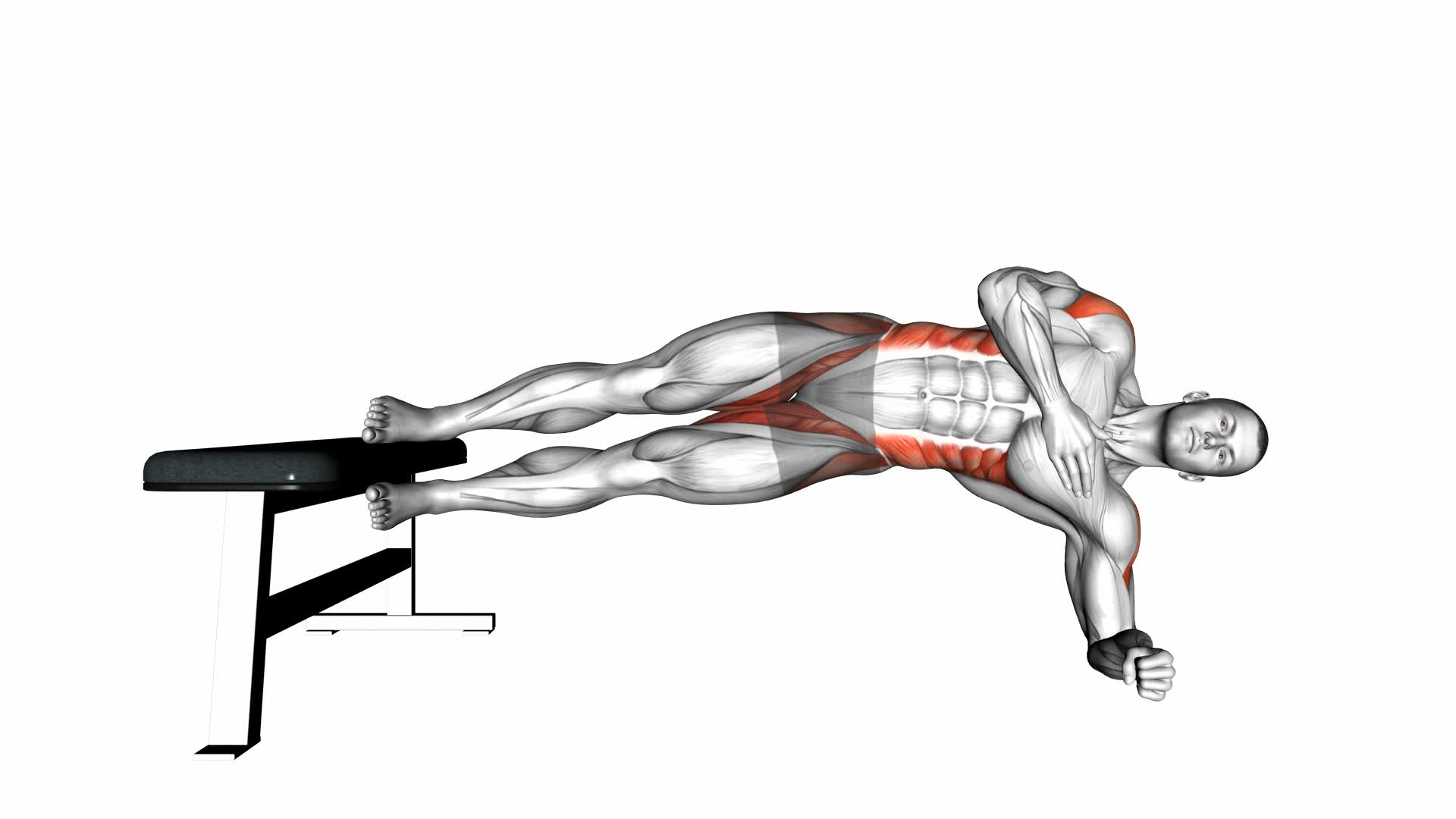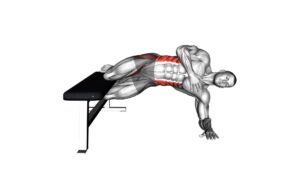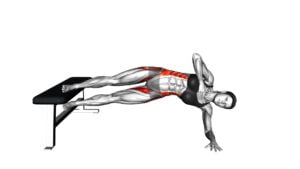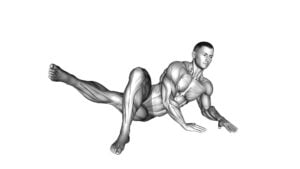Side Plank Hip Adduction – Video Exercise Guide & Tips

Are you looking to strengthen your core and hips? Look no further than side plank hip adduction!
Watch This Exercise Video
This exercise targets your obliques and inner thighs, helping you achieve a toned and stable midsection.
In this video exercise guide, we'll show you the proper form and technique, as well as modifications and progressions to challenge yourself.
Avoid common mistakes and maximize your results with these helpful tips.
Get ready to feel the burn and see the results!
Key Takeaways
- Side plank hip adduction targets obliques and inner thighs
- Proper form and technique include engaging core muscles, maintaining straight line alignment, and controlling the movement
- Modifications and progressions can be made to increase the difficulty level and challenge stability
- Consistency, proper form, and gradual progression are important for maximizing results and safety precautions should be taken to prevent injuries.
Benefits of Side Plank Hip Adduction
To understand the benefits of Side Plank Hip Adduction, you should know that this exercise engages multiple muscle groups while improving stability and core strength. Hip adduction exercises, such as the Side Plank Hip Adduction, are highly effective in targeting the inner thigh muscles, also known as the hip adductors. By performing this exercise, you can strengthen and tone these muscles, enhancing your overall lower body strength and stability.
One major benefit of Side Plank Hip Adduction is its ability to improve hip stability. As you lift and lower your top leg during the exercise, you challenge the muscles responsible for stabilizing the hip joint. This can be particularly beneficial for athletes and individuals involved in activities that require quick changes in direction or explosive movements.
Additionally, Side Plank Hip Adduction offers variations that can further enhance its benefits. By using resistance bands or ankle weights, you can increase the intensity of the exercise and further target the hip adductor muscles. Furthermore, by incorporating different variations of side plank exercises, such as the side plank with leg lift or side plank with knee tuck, you can engage additional muscle groups and add variety to your workout routine.
Proper Form and Technique
Engage your core and align your body in a straight line from head to toe while performing the Side Plank Hip Adduction exercise. Proper form and technique are crucial to maximize the benefits of this exercise and prevent injury. Here are some key points to keep in mind:
- Maintain a strong core: Engaging your core muscles not only helps stabilize your body but also enhances the effectiveness of the exercise. Focus on pulling your belly button towards your spine throughout the movement.
- Keep your body aligned: Make sure your shoulders, hips, and ankles are stacked in a straight line. Avoid sagging or lifting your hips too high.
- Control the movement: Slowly lower your hip towards the ground without touching it, and then lift it back up to the starting position. Avoid any sudden or jerky movements.
- Breathe properly: Inhale as you lower your hip and exhale as you lift it back up. This helps maintain control and stability throughout the exercise.
The Side Plank Hip Adduction primarily targets the obliques, gluteus medius, and adductor muscles of the hip. It also engages the muscles of the core, including the transverse abdominis and the muscles of the lower back. By strengthening and stabilizing these muscles, you improve your core stability, which is essential for overall strength, balance, and injury prevention.
Modifications and Progressions
Make modifications and progressions as you become more proficient in the Side Plank Hip Adduction exercise.
Once you have mastered the basic side plank hip adduction, you can start incorporating side plank variations to challenge yourself even further.
One modification you can try is the side plank with leg lift. In this variation, instead of bringing your top leg in towards your chest, you lift it up towards the ceiling. This targets not only your hip adductors but also your glutes and core muscles.
Another advanced progression is the side plank with resistance band. You can wrap a resistance band around your thighs and perform the hip adduction movement while maintaining the side plank position. This adds an extra challenge by providing resistance to your hip adductor muscles.
As you continue to improve in strength and stability, you can also try more advanced hip adduction exercises such as the side plank with knee drive or the side plank with dumbbell.
Remember to always listen to your body and progress at a pace that feels comfortable for you.
Common Mistakes to Avoid
To prevent common mistakes, consistently focus on maintaining proper form and alignment during the Side Plank Hip Adduction exercise. Proper alignment is crucial to ensure that you engage the correct muscles and avoid unnecessary strain. Here are some common mistakes to avoid:
- Dropping the hips: One of the most common mistakes is allowing the hips to sag or drop during the exercise. This not only reduces the effectiveness of the movement but also puts unnecessary stress on the lower back. Make sure to keep your body in a straight line from head to toe.
- Lack of stability: Another mistake isn't engaging the core muscles to stabilize your body. Without proper stabilization, you may wobble or lose balance, increasing the risk of injury. Focus on activating your core by pulling your belly button in towards your spine throughout the exercise.
- Incorrect leg positioning: Placing your top leg too far forward or backward can affect the alignment of the exercise. The top leg should be stacked directly on top of the bottom leg, creating a straight line. This ensures proper engagement of the hip adductor muscles.
- Poor breathing technique: Neglecting proper breathing technique can lead to tension and strain in the body. Remember to inhale deeply through your nose and exhale fully through your mouth during the exercise. This helps to oxygenate your muscles and promotes relaxation.
Tips for Maximizing Results
To optimize your results, prioritize consistency and proper form during the Side Plank Hip Adduction exercise.
Consistency is key when it comes to any workout routine, including incorporating side plank into your exercises. Make it a habit to set aside time for your workouts and stick to it. This will help you stay motivated and see progress over time.
Proper form is essential for maximizing the benefits of the Side Plank Hip Adduction. Start by positioning yourself on your side, with your elbow directly under your shoulder and your body in a straight line. Engage your core and lift your hips off the ground, keeping your body stable. From here, focus on the movement of your top leg as you bring it forward and across your body, engaging your hip muscles. Maintain control throughout the exercise, avoiding any swinging or jerking motions.
Incorporating the Side Plank Hip Adduction into your workout routine can be done in various ways. You can start by performing it as a standalone exercise, aiming for a certain number of repetitions on each side. As you progress, you can incorporate it into a circuit or superset, alternating between side plank hip adduction and other exercises. This will challenge your muscles and keep your workouts interesting. Remember to listen to your body and adjust the intensity as needed.
Frequently Asked Questions
How Many Sets and Repetitions Should Be Performed for the Side Plank Hip Adduction Exercise?
To get the most out of the side plank hip adduction exercise, you should perform multiple sets and repetitions.
By doing so, you can maximize the benefits of this exercise, such as strengthening your core and hips.
There are also variations of this exercise that you can try to keep challenging yourself.
Can Side Plank Hip Adduction Help in Improving Balance and Stability?
Yes, side plank hip adduction can help improve your balance and stability.
By engaging your core muscles and targeting the hip adductors, this exercise challenges your body to maintain proper alignment and control.
It also strengthens the muscles responsible for stabilizing your pelvis and spine.
Additionally, there are variations of the side plank exercise that can further enhance your core strength and stability.
Is It Necessary to Use Additional Resistance or Weight While Performing Side Plank Hip Adduction?
Adding resistance or weight to side plank hip adduction can provide additional benefits. It increases the challenge and intensity of the exercise, helping to build strength and stability in your core and hip muscles. This can lead to improved balance and overall athletic performance.
For advanced exercisers, there are variations of side plank hip adduction that incorporate resistance bands, ankle weights, or even dumbbells to further enhance the workout.
Are There Any Specific Muscles Targeted During the Side Plank Hip Adduction Exercise?
During the side plank hip adduction exercise, specific muscles are targeted. This exercise primarily engages your oblique muscles, which are responsible for side bending and rotation of your torso.
Additionally, it activates your gluteus medius, a muscle located on the upper part of your buttocks, which helps stabilize your hips.
The benefits of side plank hip adduction include improved core strength, increased stability, and enhanced hip mobility.
Can Side Plank Hip Adduction Be Performed by Individuals With Lower Back Pain or Injuries?
If you're dealing with lower back pain or injuries, there are modifications you can make to the side plank hip adduction exercise.
It's important to listen to your body and not push yourself too hard. Instead of performing the side plank hip adduction, you can try alternatives that put less strain on your lower back, such as side plank with knee bent or side plank with leg lift.
These variations can still engage your core and glutes while being more gentle on your back.
Conclusion
In conclusion, incorporating side plank hip adduction exercises into your fitness routine can provide numerous benefits. These include improved core stability and hip strength.
By maintaining proper form and technique, avoiding common mistakes, and gradually progressing the difficulty level, you can maximize the results of this exercise.
Remember to consult a professional or trainer for guidance and make modifications as needed to suit your fitness level and goals.
Keep pushing yourself and enjoy the benefits of this challenging exercise.

Author
Years ago, the spark of my life’s passion ignited in my mind the moment I stepped into the local gym for the first time. The inaugural bead of perspiration, the initial endeavor, the very first surge of endorphins, and a sense of pride that washed over me post-workout marked the beginning of my deep-seated interest in strength sports, fitness, and sports nutrition. This very curiosity blossomed rapidly into a profound fascination, propelling me to earn a Master’s degree in Physical Education from the Academy of Physical Education in Krakow, followed by a Sports Manager diploma from the Jagiellonian University. My journey of growth led me to gain more specialized qualifications, such as being a certified personal trainer with a focus on sports dietetics, a lifeguard, and an instructor for wellness and corrective gymnastics. Theoretical knowledge paired seamlessly with practical experience, reinforcing my belief that the transformation of individuals under my guidance was also a reflection of my personal growth. This belief holds true even today. Each day, I strive to push the boundaries and explore new realms. These realms gently elevate me to greater heights. The unique combination of passion for my field and the continuous quest for growth fuels my drive to break new ground.







